Mites are some of the smallest bugs present around the world.
Their reduced size doesn’t impact their common nature as there are thousands of species of mites.
Some mites feed on decaying food while others feed on fungi or directly on plants.
Mites look differently and have a different diet depending on their species.
While small, mites are responsible for various health problems such as respiratory allergies and skin allergies.
Table of Contents
What are mites?
Mites are very small arachnids, a group of bugs that also includes spiders. They measure 0.04 inches or just up to 1mm which sometimes make them difficult to spot without a magnifying glass.
Mites come in different colors such as red, green, yellow, white, or brown.
They have 8 legs, similar to spiders.
Most species of mites are seen as pests. They can invade homes as in the case of dust mites, gardens, as in the case of spider mites, or bee colonies as in the case of the Varroa mite.
Types of Mites
The most common types of mites are seen as detrimental or even as pest species. They are common around the world.
1. Clover Mites
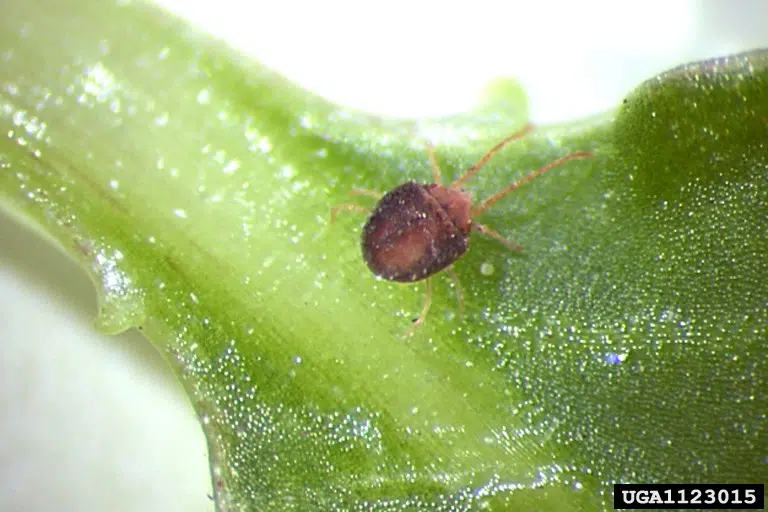
Clover mites are the most common mites and one of the species that are the easiest to recognize.
These mites are the only species to have a pair of elongated front legs. The 2 legs first look like antennae, but they are used for crawling.
Clover mites are red-brown and they grow to 0.85mm.
They are commonly found in homes where they are seen as an invasive species of potted plants.
Clover mites feed on the sap of various plant leaves. Their presence is signaled by white marks on the leaves.
These mites are very common in homes and around homes with dense vegetation.
Trimming the lawn and eliminating the vegetation next to the foundation of the house is recommended to keep clover mites out of the house.
Vacuuming is one of the easiest methods to get rid of clover mites whenever they make it into the house.
While these mites don’t bite, they can leave red marks around the house when crushed.
Clover mites can move indoors when the weather changes rapidly.
Sudden temperature changes prompt these mites to move indoors where they can remain and live even in the winter if they can feed on potted plants.
2. Spider Mites
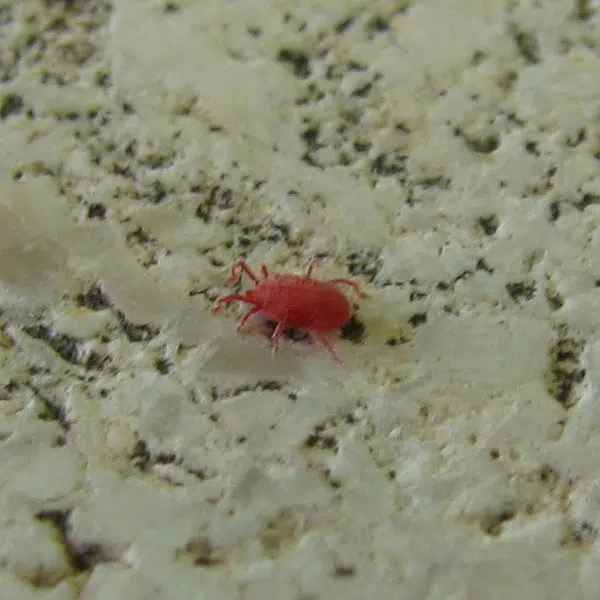
Spider mites are one of the most invasive species in gardens.
As Clover mites, spider mites feed on the sap of various plant leaves such as on the leaves of strawberries.
These mites also grow to a maximum size of 1mm which means they cannot be easily spotted on plants unless they live in large groups.
Spider mites are among the most common species of outdoor mites as they rarely move indoors.
Even during the winter, Spider mites prefer to become dormant in the ground.
Spider mites are known for eating almost all plant leaves for their sap. They resemble spiders as they build cotton-like webs.
These webs are wrapped around the mites and their eggs. This protects them from potential predators and high wind.
Spider mites are among the species known for coming in different colors from green to red or even brown.
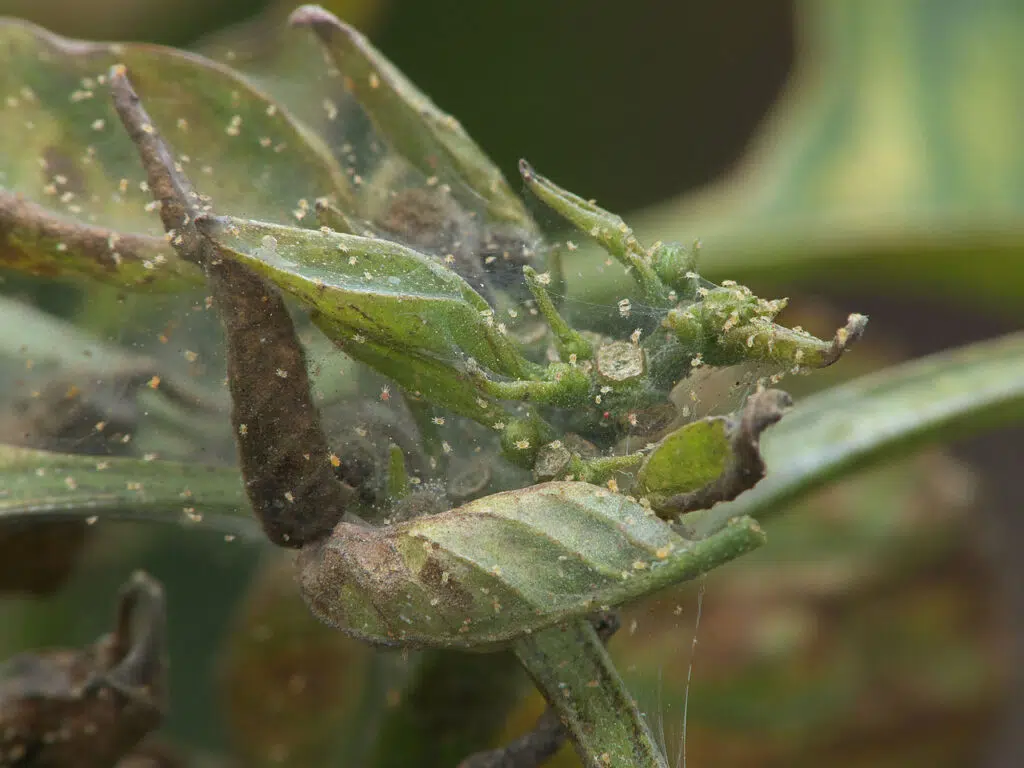
These small bugs start to hatch within 5 days. They don’t need to mate to reproduce.
A female Spider mite can start laying up to 20 eggs per day quickly covering the plant in 140 eggs within a week.
Once these eggs hatch the plant they live on can quickly die as they begin drinking its sap.
3. Demodex Mites
Demodex mites are small mites that feed on hair follicles and skin cells.
These mites are so small that they can feed on the dead skin cells on the face while sleeping.
Highly common in people with weak immune systems, these mites are among the species that cannot be observed with the naked eye and which may not be eliminated without the help of a doctor.
It’s the reactions that these mites cause that prompt most people to visit the doctor.
Common reactions to Demodex mite bites include itchy skin, red skin, and other similar symptoms, especially around hair follicles.
Medical treatments are needed to get rid of these mites from the head.
Doctors can prescribe various medications as well as non-medication treatments such as applying benzyl benzoate or salicylic acid on the skin.
In most cases, these mites either occur on people with a certain predisposition or they occur on people that barely notice their presence.
People with acne are predisposed to suffering from these small mites. Even with treatment, the mites can return to the head of these people.
However, Demodex mites are generally not even noticed on the skin or in the hair.
They live up to a few weeks on the head, they die, and they decompose on the head of the host without even being noticed.
4. Dust Mites
Dust mites are the most common mites in the house. They live in almost every home.
These mites rise in the air with dust particles which inspires their name.
However, Dust mites don’t eat dust. They eat skin cells from humans and they absorb water from the air.
Dust mites thrive in homes with clutter where there’s plenty of dust and where they can easily be absorbed in bedsheets, mattresses, and pillows.
Dust mites are a common sight in homes where people have allergies as they sometimes cause allergies without residents even realizing it.
Sneezing or having a runny nose is one of the symptoms Dust mites come with for those with allergies.
The way these allergies are triggered is by the body wrongly thinking they are a danger to the immune system.
The body starts to produce a protein specific to the immune system and to react as if the dust mites in contact with the allergic person are of great danger triggering sneezing and other similar reactions.
People with these types of allergies eventually end up at the doctor.
Antihistamines and nasal sprays are often recommended against these types of mites.
Another solution recommended against Dust mites is always having a clean home.
Frequent dusting and vacuuming help reduce their numbers.
Washing clothes and bedsheets at high temperatures also helps get rid of Dust mites without further interventions.
5. Chiggers
Chiggers are a common mite species in parks, grassland, shrubland, and dense vegetation.
These small mites are known to bite, which makes them problematic for people with certain allergies such as skin allergies.
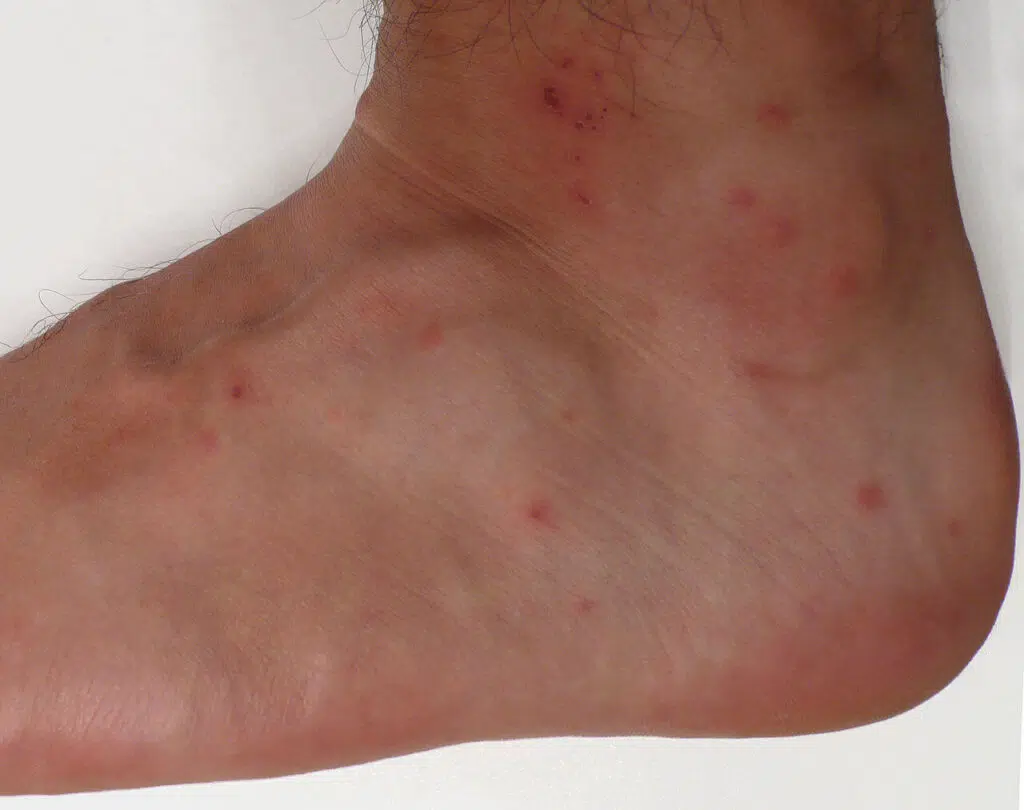
You can pick up chiggers by walking in the park, hiking, or camping.
It’s not the adults that bit but their larvae that cannot travel far for food.
Once attached to clothes the larvae of chiggers move onto the skin to bite.
It also inserts saliva into the skin which results in an itchy bite.
Chiggers don’t carry diseases but they can be a considerable trigger for allergies.
Their bites can be itchy for days and even up to a week.
Getting rid of chiggers on the body involves taking a good bad and using a sponge to scrub the skin clean.
Chiggers can sometimes be avoided by wearing bug spray when heading out to nature or when about to spend a day in the park.
Natural essential oil sprays are also useful when it comes to preventing chigger bites.
It can take a lot of sprays to keep these mites away. At the same time, the effects of these preventive measures can be minimal as chiggers can still bite when they fall on the skin in high numbers.
6. Scabies Mites
Scabies are a type of mites known to cause skin infestation. The infestation manifests itself visibly and by itching.
People with scabies have red skin or a patch of red skin as a result of the biters.
These reactions come with extreme itching which can lead to scratching and skin-level infections.
Scabies never go away on their own simply by taking a shower.
You need to visit the doctor if you have scabies for medical treatment.
The results of the treatment are normally seen in a few weeks.
In the meantime, itching sensations might still not go away. Antihistamines and ointments might be needed to relieve these itching sensations.
Scabies like to live in-between fingers, or on the skin where the elbow is bent.
These mites are transferred by contact with other people. Pets also carry scabies, but not the type that bites people.
Scabies are transmitted through prolonged skin contact. Shaking hands is a short contact that doesn’t promote the spread of scabies.
Prolonged sexual contact and other types of long skin contact are known to spread scabies.
These mites move slowly and they need a lot of time to move from one host to another.
7. Rodent Mites
Rodent mites live on house pests such as mice. They have a 2-week lifecycle and they feed on the blood of rodents.
Mites that feed on rodents live on rodents. These mites are eliminated from the house a few days after rodents are eliminated from the home as well.
Rodent mites can escape captured dead rodents seeking their next blood meal.
They can bite humans seeking blood but they cannot live on humans.
Rodent mites die within a couple of weeks after they’ve been separated from their host.
As with other rodent-related pests, Rodent mites are also known for transmitting diseases.
These mites can cause itchy rashes, allergies, and respiratory allergies.
The airborne feces of these rodents are known to cause multiple allergies.
Seeing Rodent mites is almost impossible given their reduced size.
The best elimination methods include getting rid of all rodents in your home.
Setting up traps is one of the tested methods against rodents. Vacuuming the entire house and the mice’s nest is recommended to eliminate Rodent mites.
8. Bird Mites
Bird mites live on poultry and some wild birds. These small mites measure 1/32 inches and can be identified by a gray or brown color under the microscope.
Bird mites aren’t known for transmitting diseases to people even if they can enter homes looking for food.
These small mites get separated from their host when the host dies or when poultry leave the nest.
They feed on the blood of poultry and nest among their feathers.
Bird mites are more common in homes next to poultry nests or enclosures.
They eventually leave the home on their own or die within a couple of weeks as they have no blood to feed on.
Frequent vacuuming is recommended in homes on farms and other types of homes where poultry and wild birds can be found.
Bird mites tend to replicate quickly.
Since they live on birds, they take advantage of body heat to hatch within 3 days.
Bird mites become adults within 4-5 days, ready to lay eggs and start a new lifecycle.
Mites of this genus cannot feed on human blood and they do not bite people. Their lifecycle ends if they enter homes.
One of the best methods to eliminate them is to discard dead birds as soon as they die.
9. Ear Mites
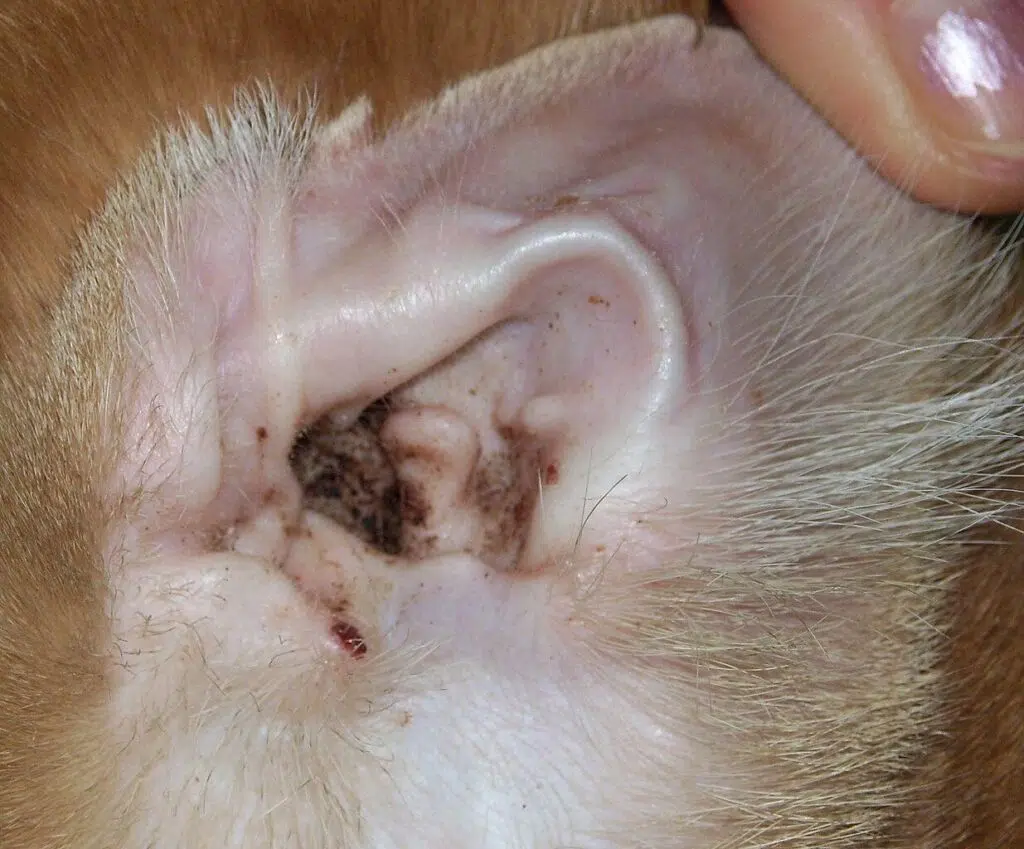
Ear mites are a common problem for pets. These small mites live in the ear canal of cats and dogs.
Preferences toward the ear canal are given by the waxy secretions of the ears.
Ear mites do not pose a threat to humans but they can impact pets.
Cats and dogs are diagnosed with Ear mites whenever owners see inflamed ears and this inflammation is confirmed by a veterinarian.
Ear mites are treated with medication as well as with other solutions so that they are eliminated.
Sometimes simply confirming an infestation is difficult as pets don’t have the patience for a veterinarian to confirm their infestation.
Ear mites are troublesome due to their rapid spread. They tend to move from one animal to another and limiting contact between pets is one of the control methods pet owners abide by.
A loss of hair or an ear inflammation are common in serious cases of Ear mite infestations.
Pets scratch their ears all the time to reduce itching sensations.
Ear mites are small, and not visible to the naked eye. Veterinarians teach pet owners how to look for these mites at home as treatment can also be applied by pet owners.
10. Oak Mites
Oak mite bites are very common in the fall in the US. These small mites are some of the most troublesome as they regularly bite people.
Oak mites are small mites that measure 0.2mm that live on oak trees. They fall from the tree or they are carried by the wind in the area and fall on people.
Oak mites can land on your skin, particularly on the neck or on the shoulders. This is where most bites are seen.
Red skin and bumpy raised skin are some of the most common reactions to oak mite bites.
While these mites don’t spread diseases, their bites are known to cause allergies.
Oak mites are further known for causing skin allergies.
The best preventive measure is to camp away from oak trees in the fall and the rainy season when up to a few hundred thousand oak mites can be washed away from a single tree.
Wearing long-sleeve clothes is recommended when hiking in oak tree forests in the fall.
Further methods of identifying these mites can help keep them away.
Oak trees with curled-up leaves or oak trees with many brown leaves are an indication of a possible oak mite invasion you need to stay away from.
11. Flour Mites
Flour mites are visible in stored flour in the pantry. These mites are only visible to the naked eye when present in clusters as they can be as small as 0.2mm.
Flour mites have a brown-red color and they can infest flour and other grains in the pantry.
The highest chance of them getting inside the pantry is by transport.
Flour mites are native to tropical and subtropical climates but they make it to temperate climates through the transport of flour.
These mites get in the pantry from the store. They rarely grow in the flour itself without being brought into the house from the store.
Flour mites may sometimes be limited in their spread through the pantry when you store flour in sealed containers.
Infested flour is known to have an altered smell and even an altered look.
Flour that has been infested by flour mites has a musty smell.
Its color might also change as you can see mite droppings in it.
Dead mites in their hundreds also lead to clumps in the flour which means it needs to be discarded following an infestation.
12. Varroa Mites
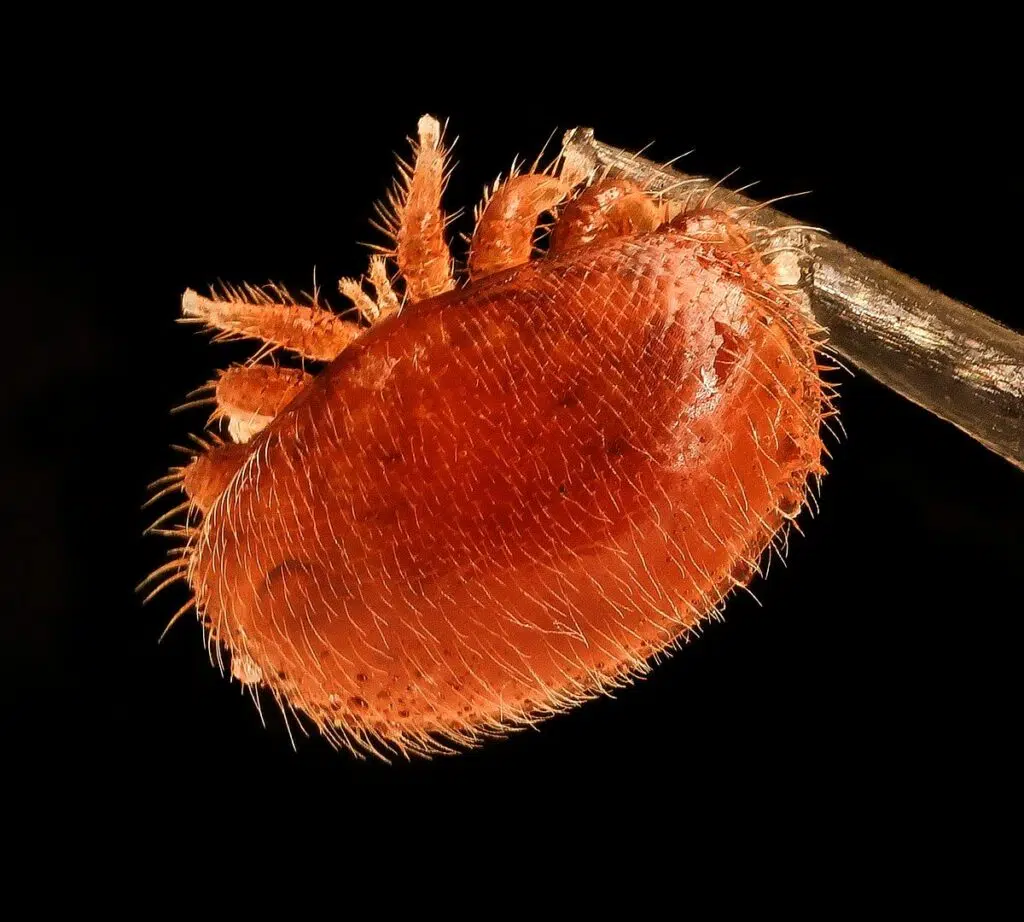
Varroa mites feed on bee larvae and adult bees. These types of mites measure up to 1.5mm and are larger than other similar species but still difficult to spot with the naked eye.
Varroa mites live with the bees themselves in the nest. The mites lay eggs on the brood and start populating the entire colony of bees.
Females eat the hemolymph or the blood of adult bees until they kill them.
These mites are very difficult to spot even if they’re present in high numbers in the first year or the first 2 years after settling with a bee colony.
Varroa mites might only be discovered after 3 years, in which time they already affected bee colonies and killed thousands of bees.
Mites of this genus spread through the import of bees and infested bee colonies.
13. Nasal Mites
Nasal mites live in the noses of dogs. Very difficult to diagnose, nasal mites can trigger allergic reactions and other health issues in dogs.
Sneezing, an itchy nose, nasal secretions, and even bleeding from the nose are all symptoms of nasal mites in dogs.
These types of reactions need veterinary attention and dogs need to be analyzed for nasal mites if they show any of these symptoms.
Endoscopy inspection is needed to confirm such cases.
Dogs undergo various treatments against nasal mites. These include anti-parasitic treatments.
14. Mold Mites
Mold mites live and feed on mold. These mites are present in high humidity areas of the house.
They typically only appear after mold has formed visibly in corners, on walls, or even on furniture.
Mold mites feed on mold and eliminating mold means they are left without any food and they die.
These mites are small and not visible. They can cause allergic reactions by spreading mold.
Mold mites cannot fly and they aren’t likely to end up on your skin. They can become airborne with air currents.
Breaking mites setae covered in mold can eventually land on your skin causing an allergic skin reaction.
Professional mold control is recommended to keep both mold and mold mites out of the house.
15. Mange Mites
Mange mites are a group of canine mites that affect the skin of healthy animals.
A large number of mange mites can cause serious health problems and the deterioration of the skin in dogs.
Canine scabies are a type of mange mites known for deteriorating the health of the skin in dogs.
These mites dig in the skin to lay eggs causing extreme itching and serious infections.
Some of these mites can even be transmitted to humans causing skin problems.
Treatment of mange mites is complicated and can take months.
Veterinarians need to take skin samples from multiple areas of the skin on the dog.
They then need to prescribe treatment after thoroughly cleaning the dog.
Parasiticides are given to dogs every week for up to a month until these mites die.
Itching might still be persistent during the period of the treatment. Both mites and their feces cause extreme itching in dogs.
Reduced contact with the dog is recommended if suffering from mange mites. Prolonged contact with dogs that carry these mites can easily favor the transmission of the mites to humans.